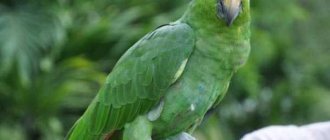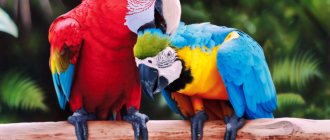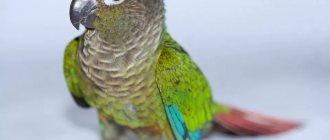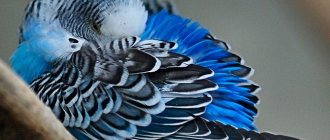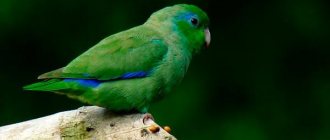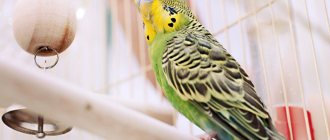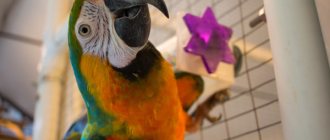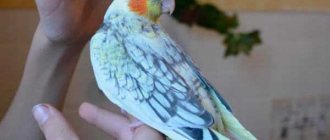To make a kakarik talk, you need to make some effort. The correct behavior of the owner and patience will lead to the fact that the jumping parrot will talk and sing songs. However, you should not expect too much from your pet. This genus is inferior to many of its counterparts in the conversational genre, but it still has certain abilities. In the article you will learn what to expect from a kakarik and what it is better not to dream about.
General description of the bird
Appearance
Kakariki is a medium-sized parrot. The body length of an adult bird is about 24-27 cm, and the weight usually does not exceed 80-90 grams. The predominant plumage color is green. Depending on the species, there are also spots of red, yellow and blue tones. The pet's tail is long, straight, wedge-shaped.
Intelligence and character
Despite its modest ability to imitate human speech, the kakariki is still an intelligent and interesting bird to watch. A parrot can be taught to perform tricks and even fly to your hand on command.
These birds are very inquisitive and are constantly busy with something. Sometimes even an untrained bird is a pleasure to watch. Flying out of the cage, the goat parrot begins to move across the floor in funny jumps.
Intelligence and character of the kakariki parrot
Pets have virtually no sense of self-preservation; when faced with something new, they immediately begin to study it. Females love secluded places; they can hide and sit silently for several hours somewhere on a shelf with clothes or in a cardboard box.
You can endlessly watch your pet eat. Hand-footed kakariki hold food in their paw, just like large species. Having received a tasty morsel in its beak, the parrot climbs higher with it and slowly eats it, sitting on one leg.
The Jumping Kakariki is a quiet and friendly pet. He gets along well with birds of other species, does not conflict and does not scream for no reason. At the same time, the bird is very active, active almost around the clock with a break only for night sleep. Females are calmer, silent, and affectionate than males.
How to distinguish a male from a female
The species is characterized by sexual dimorphism, reflected mainly in the size of the birds. Males are larger, have a relatively massive skull and stocky build. The plumage color of the birds is the same. Only the color of the iris can differ: orange for boys and dark brown for girls.
Differences between a female parrot and a male
Observing its habits will also help determine the sex of your pet. The female is very silent, sometimes she does not make any sounds for weeks, only sometimes you can hear a quiet “clucking”. Girls scream quite loudly only during the breeding season, calling for a male, stretching out and crouching at the same time. Males are also not noisy, but they sing early in the morning, quietly muttering something and are capable of shouting abruptly, trying to attract the attention of the owner.
Why can a kakarik talk?
Any species of parrot is, by definition, a very sociable bird. The feathered pet happily talks with its relatives, and if they are not there, then the owner will do for these purposes. A tamed and trained parrot is many times superior in intelligence to any domesticated animal, including dogs and rats. Many experts believe that in terms of level of communication and intelligence, such birds can compete with four-year-old children - the conclusions suggest themselves.
It should be noted that the ability to learn human speech is present predominantly in males - this is true for almost all species of parrots. Females are not very willing to talk, so it is much more difficult to teach them to do so.
What is the reason? This is one of the manifestations of the bird's instincts. A parrot is able to imitate not only the human voice, but also the sounds of other animals. They need this for protection. A gentle, weak parrot with a beak that is practically useless as a weapon is an ideal prey for many predators. Therefore, the male protects his family with his voice. For example, if some snake is sneaking towards the nest, the parrot imitates the cries of a mongoose, which frightens the hunter.
The feathered pet happily talks to its owner
Accordingly, the ability to speak in other people's “voices” is quite natural for parrots, in particular kakariki. And the bird owner has every opportunity to take full advantage of this.
Why can kakariki talk? Some believe that this is a manifestation of the parrot’s ability to think and show other signs of developed intelligence. This statement is mainly relevant for owners of feathered pets who want to believe that their pets are more than just birds. Others are of the opinion that parrots' talking has nothing to do with thought processes or mental abilities.
Both the first and the second are simultaneously right and wrong. It goes without saying that birds, including parrots, do not have such a developed intelligence that they think and can consciously communicate with humans. However, the statement that this has nothing to do with mental abilities is also not entirely true. The bottom line is that kakariki simply reproduce previously heard sounds. They can be of any origin - the cries of some animals, the voices of people, etc. If a parrot lives in captivity for a long time, it begins to imitate human speech
This is done, among other things, to try to draw attention to one’s person.
Kinds
Red-fronted
The most common species kept in captivity. This variety of kakariki was first brought to European countries in 1873, and to Russia a hundred years later. Under natural conditions, the red-fronted parrot lives on the islands of New Zealand, Norfolk and Caledonia.
The body of the bird is grassy green. On her head is a scarlet “cap”. A characteristic feature is a horizontal red stripe that crosses the eye and spots near the rump. In individuals of the classic color, the coverts, flight feathers, and undertail feathers have a blue edging along the edge. The beak is gray with a metallic tint and a black tip.
Red-fronted kakariki
There are variations of a completely or partially yellow color, as well as olive color. At the same time, the red spots retain their previous location, characteristic of the subspecies.
Yellow-fronted
In the wild, it settles in the forests of New Zealand. It appeared among Russian pet lovers in 1975.
The main plumage has a bright green color. It differs from the previous species in the golden-yellow “cap” on its head and the bluish tint of its beak. The stripe at its base and spots on the rump are scarlet.
Read also
Yellow-fronted Amazon
New Zealand mountain
It lives in the alpine forests of New Zealand, on the northern half of the South Island. Rarely found in captivity. The beak is gray-blue with a black tip. It is distinguished by its green color of plumage, having a light green tone on the abdomen, and a red “cap”. Lives for about 17 years. An endangered species. Listed in the Red Book.
New Zealand mountain species of kakariki parrot
Read also
Australian Mountain Parrot
Antipodean jumping
This is the largest representative of the kakariki parrots. The body length of an adult is about 29-32 cm, and the weight reaches 135 grams. The name of the species is consonant with the name of the islands, the meadows of which are inhabited by birds in nature.
The birds are distinguished by their green body color. The undertail, chest, and abdomen have a yellow tint. The elytra are blue with a purple tint. The light silver beak has a black edging.
Bad mood
Along with other reasons, the silence of a parrot can simply be caused by a bad mood. This phenomenon is most often observed during the changing seasons. In spring and autumn, birds, as well as people, suffer from a lack of sunlight and vitamins. These factors have a depressing effect on the bird’s overall health, causing sluggish movements and a lack of desire to tweet.
It is also important to note that budgies are naturally prone to mood swings - cheerfulness and chirping are often replaced by sadness and silence. This behavior should not alarm you until it becomes the norm for your pet.
Habitat
The jumping parrot lives mainly in New Zealand. It also inhabits a number of nearby Pacific islands. Depending on the species, the bird lives in meadows or mountain forests.
Due to such dispersal into individual territories, seven species of kakariki were formed. Three of them are already extinct, the rest are endangered. The reason for this is uncontrolled deforestation by humans and the colonization of the usual habitats of parrots.
Parrot habitats
The way of life of birds is interesting. They spend most of their time on the ground, searching for food in the forest floor. At the same time, parrots rake leaves with their paws, like domestic chickens. This natural need for digging should be taken into account and the pet should be given this opportunity in captivity.
Didn't adapt to the new home
If your pet has only recently settled in a new home, you should not sound the alarm about his long silence. Often the absence of sounds is caused by stress caused by moving and a different living environment.
During the first time after acquiring a pet, the bird goes through a period of adaptation, which may be accompanied by such manifestations as lack of appetite, depression, lethargy and even apathy. The parrot is silent and does not make contact. These are completely normal symptoms that can last from two weeks to a month. During this period, the chick gets used to its new home and environment.
If a change of home is also accompanied by a change of owners, then the parrot will be in even greater shock, which can be expressed in indigestion, wary and even aggressive behavior. Moreover, the more crowded and noisy the environment, the quieter and more withdrawn your pet will be.
Be patient - in just a few weeks the bird will adapt to the new conditions and will be cheerful and cheerful again!
Keeping at home
Cage structure
The kakariki cage is characterized by its own characteristics. In particular, this is a sufficient bottom area where birds spend a lot of time. The recommended dimensions of a bird's home are at least 85x55x90 cm. But a New Zealand parrot will feel more comfortable in an aviary.
The second significant point when selecting a cell is its shape. Birds are very active; they love to run briskly in circles, moving along the walls and ceiling of their house.
Setting up a cage for a parrot
Therefore, the pet’s home should be square or rectangular in shape with a flat top and horizontal metal bars. The width between them is recommended to be no more than 2 cm, so that the pet does not stick its head into the gap and gets stuck.
You will need to install several wooden perches so that the parrot can fly freely from one to another. It is necessary to securely secure three feeders for different types of food, an automatic drinker and a bath with water.
Care and hygiene
It is important for your pet's health to keep its habitat clean. Kakariki like to collect food from the floor, which means that regular bedding changes are of particular importance. Given the bird's natural need to dig, it is not enough to cover the bottom of the cage with paper; filler will be required. A good option is corn or wood.
Hygienic cleaning is carried out at least twice a week. All items in the cage are also washed regularly. Water and food are changed twice a day, morning and evening.
Hygiene and care of kakariki
What to feed
The diet of kakariki differs from the menu of other species due to the large proportion of succulent food in its composition. The grain mixture for medium-sized parrots should not exceed 30-40% of the food volume, the rest being fruits, berries, vegetables and herbs.
The tidbits can be mixed into a salad or strung on thick wire and hung in a cage. The berries are given both fresh and dried.
Your pet will be happy to treat you to:
- viburnum;
- grapes;
- cherries;
- cherry;
- raspberries;
- currants;
- blackberries;
- strawberries;
- sea buckthorn
Parrot diet
Some pets prefer to take out and peck only the seeds, practically without touching the juicy pulp.
You can offer your parrot pieces of fruit: apples, kiwi, banana, prunes, apricot, pear or peach. It is undesirable to eat fruits rich in essential oils, such as mango, avocado, persimmon, papaya.
Vegetables are also an important part of a bird's diet. Give your feathered friend grated or cut into pieces carrots, beets, Chinese cabbage, celery, pumpkin, and zucchini.
Prohibited foods include salted, smoked, fried and fatty foods from the human table. You cannot eat garlic, potatoes, radishes, celery root, or eggplant.
The value of greens lies in their richness in vitamins and microelements. It is not advisable for birds to consume such food at night due to the low nutrient content and the difficulty of digesting the coarse fibers in the composition.
What not to feed your parrot
Plants suitable for feeding the New Zealand parrot are:
- quinoa;
- woodlice;
- dandelion;
- plantain;
- clover;
- yarrow;
- lettuce leaves;
- spinach.
You can also grow millet and oats on the windowsill all year round, the greens of which birds also love. Once a week, the diet is supplemented with the yolk of a chicken egg.
Feeding kakariki must be approached with all responsibility. With an unbalanced diet, the parrot develops excessive feather loss, prolonged molting and baldness. The cage must contain mineral supplements, sepia or chalk. From time to time, the bird is given vitamin supplements, but this must be done very carefully, strictly following the instructions for use and dosage.
Plants suitable for feeding parrots
Mechanisms of action
Choose a short word to learn, such as “Hello” or “Hello.” Repeat it many times in an even voice and with the same intonation. If the kakarik responds with any sound, treat it with a seed or whatever it likes most. To associate a greeting with its meaning, say hello to your parrot every morning and when you come home from work. Over time, having missed communication during the day, the kakarik will begin to say hello as soon as you enter the house.
The sounds “Ш”, “Ч” and “С” are well perceived and remembered by the parrot. When choosing words to memorize, try to use these sounds. They may contain his or your names - Sasha, Masha, Pasha.
Connect the words you study with actions. For example, when opening the cage door, repeat “Let’s go” or “Walk” every time. Very soon the parrot will know that this word means free flight around the room. He will love it and will definitely want to repeat it.
How to tame
Kakariki are not particularly shy, so they quickly make contact with humans. The pet can sit on the outstretched hand of the guest with a treat already at the first meeting. The main thing is not to intentionally frighten the parrot, not to undermine his trust in the world.
The stages of taming are the same as when raising other species:
- Eating treats in the presence of the owner.
- The parrot sits on the palm.
- Walking outside the cage and learning the command “Come to me!”
Encouragement should only be positive. You can use sunflower seeds or dried viburnum berries for treats. After mastering the basic skills, they begin training the pet, teaching tricks and talking.
Using toys
Since a jumping parrot is an active, curious bird, the living area must be equipped with toys. All kinds of ropes, a mirror, a ladder, swings and balls will not let your pet get bored.
Use toys to tame your parrot
Safety precautions
The New Zealand Jumping Parakeet's curiosity is stronger than its sense of self-preservation. Therefore, in captivity, birds often become victims of accidents or poisoning by inedible substances. When walking mainly on the floor of an apartment, a pet may suffer from the claws of other pets or be accidentally crushed by a person’s foot.
Females like to hide in dark, secluded places. As a result, the parrot may be pinched by a drawer or accidentally locked in a closet. There are known cases when birds were taken outside in a coat pocket and were stepped on by a bird hiding inside a shoe. Curious pets climb into the ventilation hatch, sink drain, fireplace chimney, boxes, and pots.
From all this we can conclude that kakariki should absolutely not be left unattended during a walk. Before you let your bird fly, make sure all cabinets are closed, cords are hidden, pets are isolated, and the rest of the family is aware of your intentions.
Safety precautions for the kakariki parrot
Loneliness
In cases where your pet is usually healthy and cheerful, but suddenly becomes depressed, it is worth considering whether the bird is receiving enough attention. Often a budgie or cockatiel is silent because it lacks communication. It's all because of simple loneliness!
By nature, parrots are very sociable creatures. They live in flocks whose size can exceed several hundred individuals. This means that in their natural habitat, parrots are never left alone. That is why these birds constantly need to be around people or their own kind, otherwise they will simply get bored, which will negatively affect their health and general condition.
Don't underestimate the negative impact of loneliness on your parrot's well-being. Experts note that a severe form of depression can cause self-plucking syndrome, to which grays and cockatoos are most susceptible. If the processes that have begun are not stopped in time, the disease can lead to death.
In order to provide your pet with a comfortable existence, you can diversify its house with toys and various devices for relaxation and learning. It would also be a great idea to purchase a couple of pets at once! Many bird owners confirm that keeping several individuals of the same species in one cage at once significantly improves the life of the birds, and also contributes to their learning and development!
Diseases and prevention
A common problem when keeping kakariki at home is the seasonal change of plumage. This natural process for birds in this species can acquire a protracted tendency, accompanied by bald patches on the body throughout the year.
To normalize molting, you need to balance the diet, add more vitamins and microelements, and exclude fatty seeds and nuts. Pay more attention to your pet; perhaps he is engaged in self-plucking from lack of communication.
It is important to follow the birds' daily routine. For proper rest, your pet must sleep at least 12 hours. If necessary, the cage is shaded with dense fabric from artificial light sources.
Prevention and description of parrot diseases
Another important maintenance condition is the optimal room temperature. This indicator should be maintained at 17-20 degrees. Dry air is harmful to birds. Spraying water from a spray bottle is often not enough; it is better to install an electronic humidifier.
Keep the bird's habitat clean. Regular cleaning of the cage, as well as timely changes of water and food are the key to the health of the bird.
Purchase
Where to buy a bird, and what is the price? Most pet stores that sell birds have disgusting living conditions. Nobody treats the birds, they are poorly fed, and it would be better to keep silent about the toys in the cages. A jumping parrot sits for days in a cramped cage and suffers from idleness. The price category is too high: they can ask for 7,000 thousand rubles for a bird.
We recommend reading: Lifestyle and keeping of the loris parrot
It is easier to purchase a kakarika from a breeder. It's cheaper and quieter for the owner. Don't hand over a sick bird. Finding a breeder is not so difficult; you will have to pay from 3,500 to 5,000 rubles for a bird.
The New Zealand parrot will be an excellent pet for those who can devote enough time to it. When letting a bird fly, you need to keep an eye on it. Considering that kakariki fly for 4-5 hours, it is better to start one for those who can afford to devote that much time to watching the kakariki.
Breeding Features
Air humidity
To prevent the air from becoming dry, place a special device near the cage. Pets will reproduce only in a sufficiently humid environment. It is necessary to adhere to this indicator within 60-70%.
Matching
When choosing a partner, kakariki, like other parrots, are very selective. In this case, personal sympathy for an object of the opposite sex plays a decisive role. Even when kept together for a long time, birds can simply be friends without trying to reproduce.
Kakariki, jumping New Zealand parrots "Kiwi" & "Kolya".
It is necessary to introduce future spouses carefully so as not to quarrel from the very beginning. To do this, cages with pets are placed next to each other, and after some time the birds are released at the same time for closer communication. If they behave friendly, you can plant the birds together. When you notice signs of mating, that the male feeds the female, cleans her feathers, and she crouches and screams invitingly, you can set up a nest for them.
House size
To reproduce, birds are placed in a cage with a device that imitates a natural hollow. The optimal size of a nesting house is 20x20x25 cm. Instead, you can buy it in a store or make a nest box from a piece of a tree trunk. The diameter of the latter must be at least 15 cm.
Incubation period
Egg incubation lasts about 21-25 days. There are usually about 6-8 of them in a clutch. Although there are fertile birds that lay up to 10.
Kakariki parrots
Bathing suit
Water procedures for kakariki are especially important and loved by them. The bird bathes with pleasure every day. It is desirable that she has such an opportunity at any time. But when placing the bathing suit inside the cage, make sure the water is clean, as it will quickly become dirty. A curious pet can soak food, pieces of paper in it, and even throw fallen feathers into it. Therefore, change the liquid in the bath 2-3 times a day so that the parrot does not get poisoned.
Age for breeding
Kakariki are capable of reproduction already 4 months after hatching. However, it is not recommended to breed young birds under the age of one year.
It is also important to observe the frequency of breeding - no more than twice a year. Frequent laying of eggs can deplete the female’s body, cause her health problems and even lead to death.
Kakarik - All about the breed of parrots | Parrot breed - Kakarik
Venerable age
Another fairly common reason why a parrot does not chirp and is quiet is its advanced age. At poultry markets, there are often cases when elderly birds are sold to gullible buyers, passing them off as chicks. In such cases, silence is completely justified: birds whose age has reached 9–10 years behave much less active compared to young individuals.
At this age, the budgie does not chirp and is difficult to teach and train. Surveys of admirers of this species have shown that in old age it is practically impossible to teach such a bird to speak. The maximum that can be achieved is to imitate the sounds surrounding your pet (for example, the creaking of a door or the meowing of a cat).
What can you do
If you are lucky enough to buy an older parrot, humble yourself and provide the bird with a peaceful old age. In other cases, you can make attempts to fix something.
Expert recommendations on how to make a parrot tweet:
- Buy a pair for a phlegmatic parrot or a female. In budgerigars, sex is determined visually. Other species will require genetic testing.
- If the change in behavior is associated with a move, give the bird a little time to adapt. Do not disturb him unnecessarily, protect him from the noise and curiosity of other pets. The bird should not be released from the cage during this period. As soon as the parrot feels protected, it will begin to trust its owner. Then you can start talking to him kindly.
- If the reason for silence is loneliness, try to pay more attention to the bird. If free time is limited, play recordings of nature sounds, birdsong, and conversations of other parrots. Provide your pet with a variety of toys, hang a mirror and a bell in the cage. But the best option would be to buy him a pair.
- Changeability of mood is treated by creating comfortable conditions. Limit stress factors, pay more attention. Make sure your bird's diet is balanced.
- At the slightest sign of illness, immediately consult an ornithologist. Don't try to treat it yourself. Incorrect manipulation can only worsen the pet’s condition. Budgerigars are susceptible to vitamin deficiency, so they need regular vitamin supplements and sunbathing. Observe sanitary and hygienic standards for keeping birds in a cage.
Don't panic if your bird is sad and doesn't chirp. Observe her, analyze her behavior. Perhaps the reason for the behavior change is quite harmless. Create favorable conditions for your pet, provide proper nutrition and do not leave it alone for a long time. The parrot will live a long life, delighting with its chirping.
When we start planning to buy ourselves a feathered friend, we always count on the fact that our house will be filled with cheerful singing and funny chirping.
And now, this exciting moment has finally arrived, you brought the parrot home, introduced him to his new spacious apartment, but he is still silent.
Well, okay, we are all well aware of the extremely delicate mental organization of birds, and we understand that the bird is experiencing severe stress.
After all, just yesterday she lived in a store, surrounded by other birds, and today she found herself in an unfamiliar place and in a new cage, where the perch is not the same, and the smells are not the same, and in general, everything is completely different.
Well, it’s okay, he’ll get used to it, won’t he? But as time goes by, you notice that the parrot has already settled in well, is actively exploring new possessions and has completely calmed down.
But, as before, he continues to remain silent and completely refuses to tweet. And you already want to listen to his wonderful songs so much that now you simply don’t have the strength.
- Why doesn't the parrot chirp?
- What can I do to make my parrot start chirping?
Not tweeting because he's sick
The most alarming reason for a pet’s silence may be the initial signs of the disease. A reason for concern may be the sudden silence of the parrot, accompanied by other symptoms of an unhealthy condition, including:
Loss of appetite and lack of attention to offered treats;
- sleepy state - the bird moves little and constantly sits with a ruffled look;
- apathy, retardation of movements;
- cough or sneezing;
- indigestion, including loose stools;
- discharge from the beak, itching;
- indifference to external stimuli;
- discoloration, increased loss of feathers.
What can be done
Many of the listed reasons for quiet behavior can be corrected and you can achieve affectionate, enthusiastic, ear-pleasing chirping from your bird. But you have to come to terms with some factors.
For example, if you become the owner of an elderly bird, you should accept this as a fact and provide your pet with quality care and a comfortable old age. You should also be calm about buying a girl parrot or purchasing a naturally phlegmatic bird.
The sex of some breeds of parrots can be determined visually (for example, budgerigars), while others will require genetic testing.
In other cases, you can do the following:
- If your pet's quiet behavior is caused by moving to a new home with a new family, you should simply give the pet time to adapt. For the first few weeks, the bird should not be touched; approach the cage only for cleaning, filling the feeder and drinking bowl. In this case, all movements should be as smooth and calm as possible. You should not try to pick up your pet, make a lot of noise, let alone raise your voice, let other pets near you, or turn on music or TV loudly. Attempts to release a parrot from its cage are strictly prohibited. At this time, the bird needs the most careful, tactful and careful handling in order to feel safe and begin to trust you. When your pet gets at least a little more comfortable, you can start talking to him, but in a calm and affectionate manner.
- If your pet is silent from loneliness, there may be several options. If possible, try to spend more time with the bird, actively communicate, and conduct conversational training. If this is not possible, you can try to include for the bird a recording of the conversation of other parrots and birds, sounds of the forest or rain, and other sounds of nature. To brighten up loneliness, it is worth providing your pet with a sufficient number of toys, puzzles, and bells in the cage. A hanging mirror works well - birds are often not averse to chatting with their own reflection. You can also purchase a pair for your pet if financial capabilities and the amount of space in the house allow. Especially often they buy a mate for a budgie or lovebird. Then the birds will definitely not be bored.
- To smooth out mood swings, provide your pet with the most comfortable conditions necessary for his breed. Make sure your diet is filled with vitamins and minerals and reduce stress factors.
- If you suspect a disease, you should definitely contact a veterinarian, as you won’t be able to do anything on your own. During the examination, it is important to exclude vitamin deficiency, to which parrots are very susceptible during transition seasons. When a disease is established, it will be necessary to reconsider the characteristics of the care: perhaps adjust the diet, add more sunbathing, improve sanitary and hygienic conditions.
If your pet does not caress your ears with its muttering, do not panic prematurely.
Watch the bird, analyze all the factors - perhaps the reason for its quiet behavior is understandable and harmless. In any case, provide your pet with the best conditions, carefully care for and feed it, pay attention - then the bird will live a long time and often delight you with its chirping.
Parrots are active, inquisitive birds that are happy to get closer to humans. Throughout the day you can hear them muttering or chirping cheerfully if they have not yet learned to speak. But it happens that the parrot stops chirping. What to do in this situation?
Speaks with an accent
If, when thinking about buying a parrot, you put the ability to reproduce human speech in the foreground, then it is better to abandon the kakarika right away. These birds are hardly able to remember a dozen words, and they can only pronounce them with a terrible “accent.” It happens that the spoken word very vaguely resembles the original one, and it can hardly be recognized.
If the quality of speech is not so important for you and mutual communication with your pet is in the foreground, feel free to buy a male kakarika and start training. These parrots are very diligent and will bring you joy by showing sincere diligence in their studies.
But get ready to become a real teacher and an all-forgiving educator yourself. For those who do not know, let us explain that a jumping parrot in no way connects the words it has learned with any thoughts in its own head. He simply repeats the memorized word. So don't expect coherent chatter from him.
Training rules
The kakarik parrot is a highly active bird that is constantly on the move. He is curious and brave, but moving to a new home requires adaptation. So don't bother him for at least a few days. Let the bird get used to it and stop being afraid of your appearance near the cage. You can read more about taming in the article “Keeping Amazonian parrots using the example of the Venezuelan Amazon.”
To teach a kakarika to speak, remember some rules:
At first, lessons should be conducted in a cage, then the parrot's attention will be focused on you and what you say.
